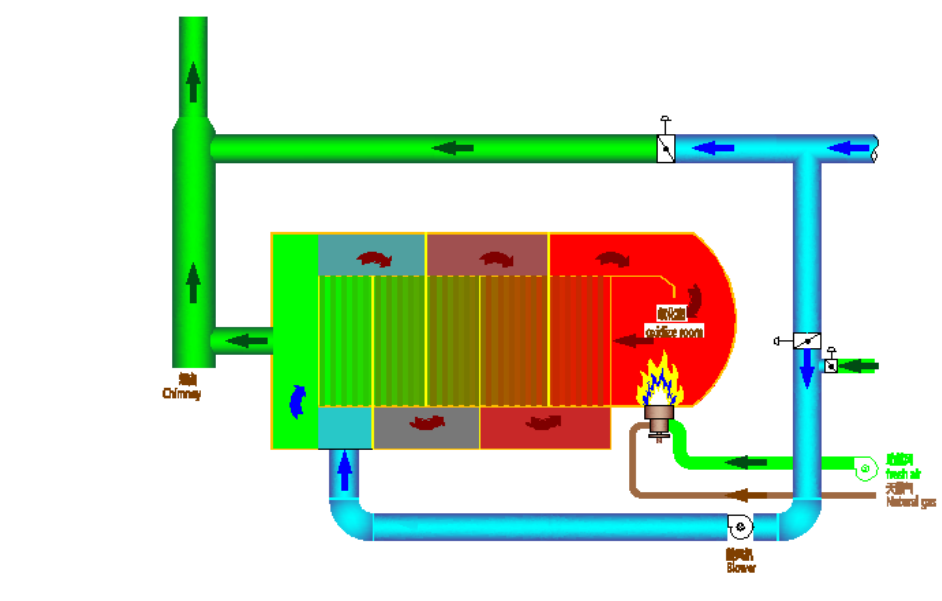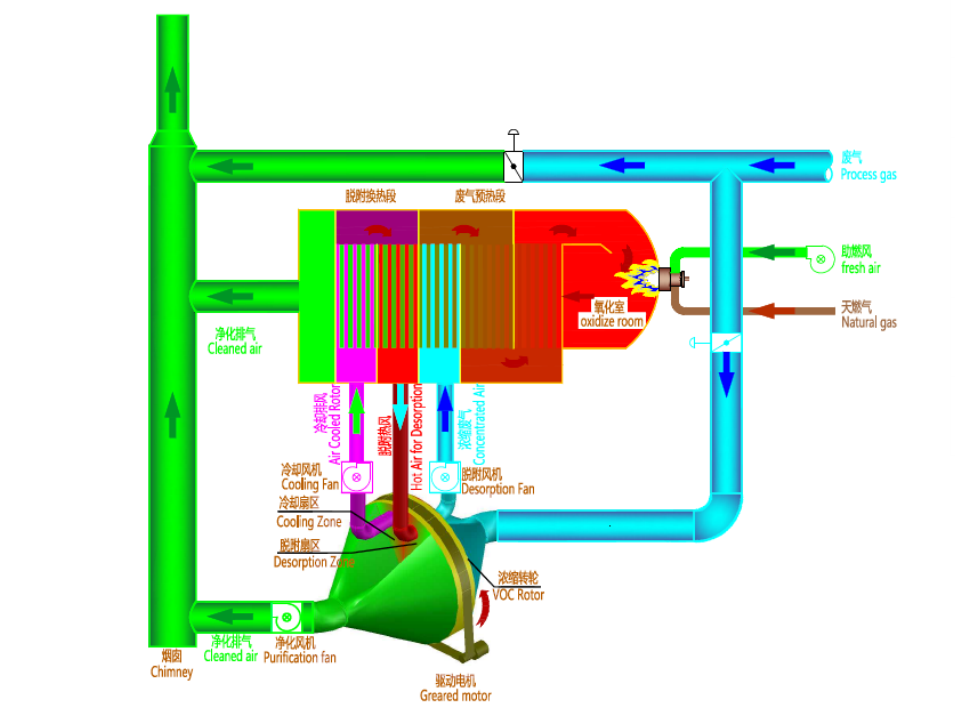PRODUCT
PRODUCT
RTO waste gas treatment
RTO waste gas treatment
Regenerative oxidation furnace RTO system organic waste gas purification treatment equipment factory waste gas treatment
Exhaust gas thermal oxidation purification technology
The condition of thermal oxidation purification is that the process waste gas is in the state of gas or water vapor, and the waste gas must be combustible. In the thermal oxidation process, the hydrocarbons contained in the exhaust gas are cracked at high temperature, react with and combine with oxygen, and are converted into water vapor and carbon dioxide. Heat is generated during this reaction
The regenerative exhaust gas oxidation furnace RTO
RTO device is mainly used to purify the exhaust gas discharged by the following industries and with a pollutant concentration in the range of 1-10g/Nm 3:
· Coating
· Chemical and pharmaceutical industry
· Paint and spraying industry
When the exhaust gas concentration is greater than 1.5 g/Nm 3, the system will reach thermal self-balancing mode. In this case, there is no need to refuel, and the three-room RTO purification efficiency can reach more than 99%
When the exhaust gas concentration is higher than 3 g / Nm 3 when taking into account the new standards may be performed after reinforcing sealing system to improve the design temperature, the purification efficiency reached 99.8%;
using anti-fouling properties of silica The ceramic regenerator can reduce the influence of silicone in the coating industry;
The exhaust gas with VOC enters the RTO equipment. In the regenerative chamber, the honeycomb ceramic body preheats the exhaust gas to above 760 ℃, and then the minimum temperature of the oxidation chamber is controlled by the burner burner. The minimum temperature of the oxidation chamber is not less than 800 ℃, and the VOC exhaust gas stays in the oxidation chamber for 0.5 -1s, and is oxidized into carbon dioxide (CO 2) and water (H 2 O) in a high temperature environment. During the oxidation process, heat is released to further increase the temperature of the exhaust gas. After passing through the regenerator, the ceramic body absorbs the heat of high temperature gas. In order to prepare for the next cycle of preheating the exhaust gas, the flue gas after cooling is discharged from the chimney to the atmosphere.
Each heat storage chamber goes through the process of heat storage-heat release-purge in turn, and it works cyclically and continuously. Due to the existence of the third chamber, the switching of the air flow is more stable. After the heat storage chamber is "heated", a part of the treated clean exhaust gas is introduced to replace VOC before the blower, and the heat storage chamber is purged. After the cleaning is completed, the "heat storage" procedure is entered, which eliminates the straight-line state of the two-chamber RTO, so that the purification efficiency reaches more than 99.5%.
The equipment is mainly composed of upper chamber body, lower chamber body, air valve, combustion system, fan, chimney, compressed air system and electrical control system.
|
Part Name |
Features |
|
Upper body |
It provides space and time for the oxidation of organic matter, and has both heat storage and heat release functions. |
|
Lower body |
Withstand the load of the upper chamber and provide exhaust air duct. |
|
Damper |
The flow of exhaust gas is controlled by the switch of the valve, and the flow of exhaust gas is controlled by the adjustment of the valve. |
|
Combustion System |
Provide heat for the temperature rise during the system startup process and the heat balance during the operation process. |
|
Fan |
Provide sufficient power for the gas to overcome the resistance of the system. |
|
chimney |
Since the treatment efficiency cannot reach 100% , the exhaust gas after treatment must be led to high altitude and the emission concentration must be measured. |
Heat recovery type exhaust gas purification TO
TO device is mainly used to purify waste gas with pollutant concentration in the range of 6g/Nm 3 or more
The heat recovery type exhaust gas purification process TO has been proven to be the best, safest and most versatile incineration method. In this way, organic pollutants are converted into water and carbon dioxide.
The device meets the most stringent regulations and will not cause secondary problems such as wastewater.
The device maintains a high removal efficiency throughout the entire service life, with minimal maintenance.
TO device technology has been widely used worldwide.
The heat recovery type exhaust gas purification process TO is most suitable for the following processes:
· Process waste gas must be purified
·The production process requires a heat source

The exhaust gas with VOC is preheated to about 550 ℃ in the heat exchanger and enters the combustion chamber.
In the combustion chamber, the temperature of the burner is increased, so that the pollutants carried by the exhaust gas are at the position of the sensor set by calculation, to ensure a combustion time of 0.5S and to ensure that the temperature of this control point is at
At 750 ℃, almost no residue will be produced. The clean gas produced after incineration is discharged to the atmosphere through the chimney through the integrated heat exchanger.
The waste heat contained in the flue gas can be recycled and used in the heat source of the process or the air conditioning system.
|
Part Name |
Features |
|
Combustion chamber |
Provide space and time for the oxidation of organic matter. |
|
Heat Exchanger |
Used to preheat exhaust gas. |
|
Combustion System |
Provide heat for the temperature rise during the system startup process and the heat balance during the operation process. |
|
Fan |
Provide sufficient power for the gas to overcome the resistance of the system. |
|
chimney |
The exhaust gas after treatment shall be led to high altitude and the emission concentration shall be measured. |
|
air compression system |
Provide power for pneumatic components. |
|
Electrical control system |
Provide power distribution for power equipment, control various components of the system, and make the system operate safely and stably. |
Adsorption and concentration technology
Zeolite wheel: used to increase VOC concentration
Zeolite is mainly used for purifying exhaust wheel means by the industry, contaminant concentrations, concentration of the exhaust gas is less than 1g / Nm . 3 off-gas in the range:
· Paint room exhaust
· Semiconductor industry
· Printing plant
For VOC waste gas with low concentration and large air volume, if it is treated by direct combustion treatment method, not only huge equipment is required, but also high operating cost
In this regard, the VOC concentration and polluted air purification device can be used to condense low-concentration and large-volume polluted air into small-volume and high-concentration air for combustion treatment. Not only can the equipment investment be reduced, but also the operating costs can be greatly reduced, and the harmless treatment of low-cost and high-efficiency VOC tail gas can be realized.

Using hydrophobic molecular sieves or activated carbon with excellent adsorption as the adsorbent can fully purify VOC waste gas under different operating conditions.
The hydrophobic molecular sieve has the characteristics of non-combustibility and high heat resistance, and can be regenerated under high temperature conditions. Therefore, high-boiling-point VOCs that cannot be processed due to regeneration temperature restrictions when using activated carbon can also be processed.
The high-temperature sintered zeolite wheel is a combination of inorganic substances. If the honeycomb passage is blocked, it can be washed with water. In addition, the molecular sieve runner can also be activated at high temperature by heat treatment according to the actual situation.
system design
Have you encountered the problem of exhaust gas treatment in the production process? The problem of excessive energy consumption? Need to meet exhaust emission standards and reduce energy costs? We can provide you with systematic solutions
· Investigate existing energy requirements, exhaust gas composition, temperature and concentration.
· Evaluate exhaust emission compliance and energy recovery from reuse.
· Evaluate possible solutions by observing the economic indicators of different types of devices.
· Provide design services in the process of formulating plans and economic evaluation.
· Submit design results.
· Assess the investment cost.
· Submit the best plan and quotation to reduce the customer's comprehensive cost
· Work with customers to develop an implementation plan.
· Provide training and guidance to your staff on new technologies.
Cases
Partner
Contact us







